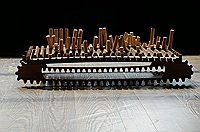Jurg Hassler
dal 21/10/2008 al 17/1/2009
Segnalato da
21/10/2008
Jurg Hassler
Tinguely Museum, Basel
Mattomatt - Chess pieces

There are various theories on the origins of chess. India, Persia and China have all been named as having invented the game, and the period of its invention is presumed to have taken place some time between the 3rd and 6th centuries. This explains the complexity of the game that contains elements from various cultures, languages and periods.
In the course of the 15th century, the rules of the game underwent a significant change so that henceforth one may speak of modern chess as it is played today.
Jürg Hassler develops new chess games with the accent on the game and the pleasure of playing, without any obligation to have to prove anything, without any obligation to have to win, but rather to invent ever new shapes of dialectical contrasts, with a decided preference given to shape over colour.
Movement – a crucial factor for Hassler from his filmmaking period – is integrated in his works in the form of chess rules that result in plastic, sculptural modifications.
Despite certain new aspects, the basic features of the game remain the same as those of past centuries: a network of coordinates to enable strategic moves of the figures: foot soldiers, combat elephants, messengers, knights – a game with endless possibilities.
In real combat situations, the generals were relatively safely placed away from the heat of the action. Thus, Hassler starts to shape the chessboard as a terrain with one hill, with two hills, with a river. He soon abandons the strict colour differentiations in favour of other formal distinctions, so that, at the end, the network of coordinates disappears completely from the game board. The figures or players have to orient themselves differently. As a consequence of this step, the traditional chess figures placed on their squares become in part a feature of the system of orientation by themselves adopting the shape of an individual square or part thereof.
The search for confusion grows more and more, though one must be able to play each game. Time is of no consequence. In more recent works, the players are increasingly encouraged to shape the terrain in common and, during the game, to place the figures on their squares so as to achieve a “beautiful” order; thus, depending to one’s understanding of the game and its rules, a chaotic hazard ensues in the formal constellation that may be corrected by the players along aesthetic lines within the relatively narrow context of the game.
The interest lies in the constant exchange between apparent chaos and order, between form and lack of form, and a different, slightly sidelong glance, affords a new way of seeing.
This multi dimensional surpassing of the imaginative powers in order to shape modifiable chess pieces into a landscape or an architectonic composition requires flexibility and a fresh conceptual approach. It further adds to the pleasure of the game, which is Jürg Hassler’s real aim: to free chess from its restrictive and rigid conventions.
Tinguely Museum
Paul Sacher-Anlage 1 - Basel



